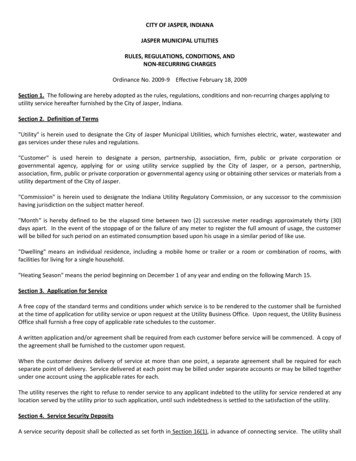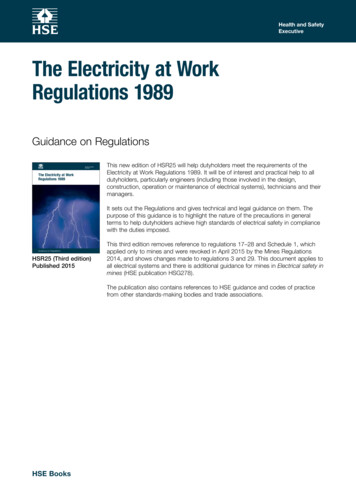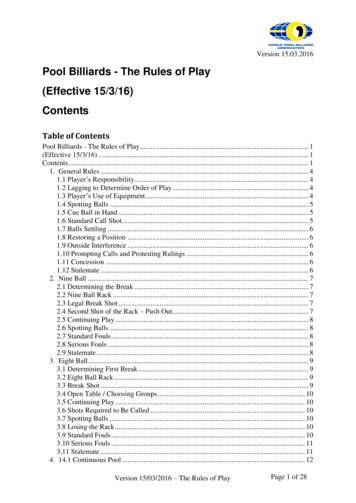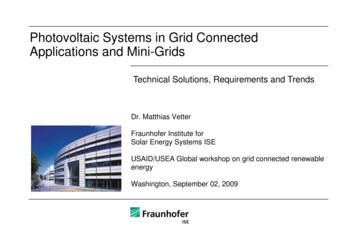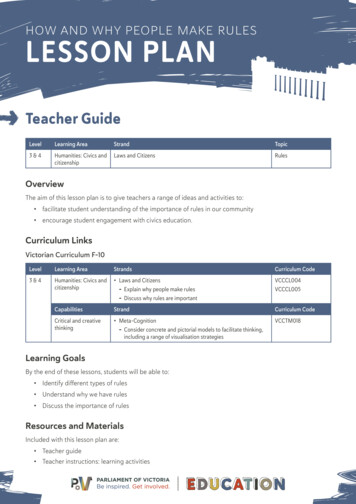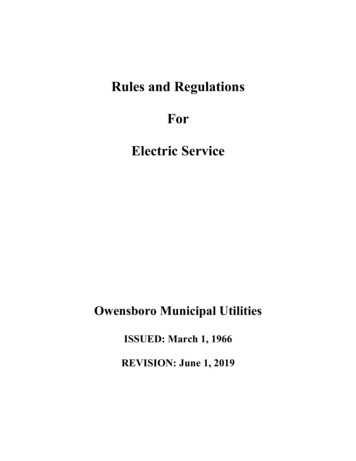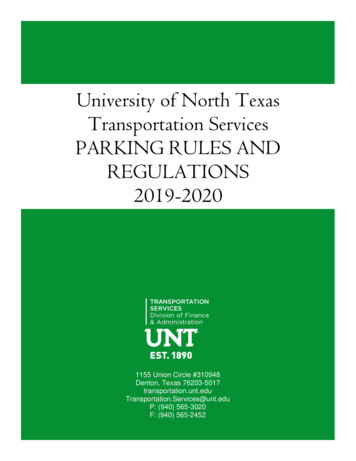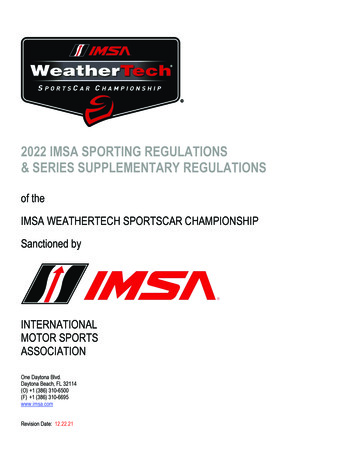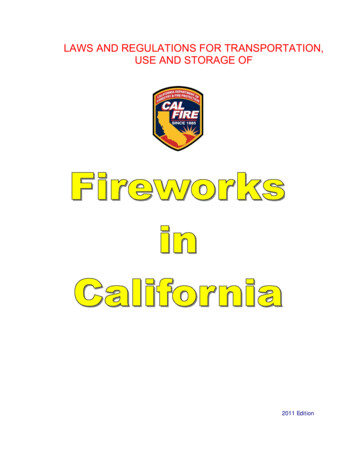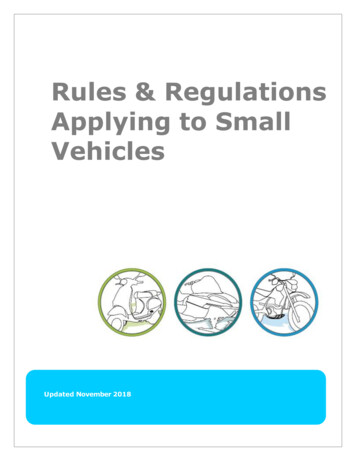
Transcription
Rules & RegulationsApplying to SmallVehiclesUpdated November 2018
June 2010ContentsIntroduction. 3Common Definitions. 4Quick Reference Guide . 5Motorcycle Helmets. 6Power Bicycles . 7Mopeds . 9Motorcycles .11Mobility Aids .13Off-highway Vehicles.15Prohibited Miniature Vehicles .202
IntroductionOperating a small vehicle is a high risk activity. These vehicles are lighter, less stable, andmore vulnerable in a crash than other vehicles on the road. New riders are at the greatestrisk of having a collision because they are unfamiliar with the controls and handlingcharacteristics of small vehicles.Even if you are an experienced automobile driver, when learning to ride a small vehicle, beaware that you are once again a beginner. Always ride with a safe attitude. Try to anticipateand avoid dangerous situations by riding safely. Being involved in a crash can mean a lossof income, health and possibly a life.This handbook is a good source in understanding the rules and regulations applying tosmall vehicles. For other driver handbooks and to understand more about road safety andlow risk driving pick up a Basic, Motorcycle and/or Professional Driver’s Handbook at anAlberta Registry Agent office or cles.htmAlthough efforts have been made to reflect the current state of the legislation andregulations at the time of its original publishing, this publication has no legislative sanctionand is not intended to take the place of the Traffic Safety Act and Regulations or otherlegislation from which in part it is derived. The user is encouraged to refer to the sourcelegislation at: http://www.transportation.alberta.ca/525.htm for purposes of interpretingand applying the law. Any reliance on the information contained herein is done so at thereader’s sole risk.A message from Alberta TransportationOctober 20173
Common DefinitionsImportant common definitions that may apply to more than one of the vehicles listed in thisguide:1. Cycle – “cycle” means a bicycle, power bicycle, motorcycle or moped.(Traffic Safety Act, Section 1)2. Motorcycle – “motorcycle” means a motor vehicle, other than a moped, that ismounted on 2 or 3 wheels and includes those motor vehicles known in theautomotive trade as motorcycles and scooters. (Traffic Safety Act, Section 1)3. Motor vehicle – “motor vehicle” means (i) a vehicle propelled by any power otherthan muscular power, or (ii) a moped, but does not include a bicycle, power bicycle,an aircraft, an implement of husbandry or a motor vehicle that runs only on rails.(Traffic Safety Act, Section 1)4. Vehicle – “vehicle”, other than in Part 6, means a device in, on or by which a personor thing may be transported or drawn on a highway and includes a combination ofvehicles but does not include a mobility aid. (Traffic Safety Act, Section 1)5. Highway – “highway” means any thoroughfare, street, road, trail, avenue, parkway,driveway, viaduct, lane, alley, square, bridge, causeway, trestleway or other place orany part of any of them, whether publicly or privately owned, that the public isordinarily entitled or permitted to use for the passage or parking of vehicles andincludes:i. A sidewalk, including a boulevard adjacent to the sidewalkii. If a ditch lies adjacent to and parallel with the roadway, the ditch, andiii. If a highway right of way is contained between fences or between afence and one side of the roadway, all the land between the fences, orall the land between the fence and the edge of the roadway as the casemay be, but does not include a place declared by regulation not to be ahighway.(Traffic Safety Act, Section 1)4
Quick Reference rbicyclesNO12NONOYESmopedsCLASS 714YESYESYESmotorcyclesCLASS 616YESYESYESmobility aidsNON/ANONONOoff-highwayvehiclesYES NO14YESYESYESprohibitedminiaturevehicles5It is prohibited to operate thesevehicles on roadways or sidewalks.
Motorcycle HelmetsMotorcycle helmets are worn by riders of:1. Power Bicycles (A rider may also wear an approved bicycle helmet)2. Mopeds3. Motorcycles4. Most Off-Highway VehiclesApproved Helmet Standards: Motorcycle Helmets must have the mark or label stating itmeets one of the following standards: CSA, DOT (Standard 218), BSI, the applicable SnellMemorial Foundation standard, or the ECE.The following are adopted and apply to safety helmets in accordance with subsection (1):a) CSA Standard CAN3-D230-M85;b) DOT Standard 218 under part 571.218 of the code of Federal Regulations (UnitedStates), Title 49;c) British Standards Institute Standard BS 6658 – 1985;d) Snell Memorial Foundation Standard M2000;e) Snell Memorial Foundation Standard M2005;f) Snell Memorial Foundation 2010 Standard For Protective Headgear;g) United Nations Economic Commission for Europe Regulation 22-05.No person shall buy, sell or offer for sale a safety helmet intended for the use of operatorsor passengers of cycles, and off-highway vehicles, unless it complies with the standard.To ensure your personal safety, maintain your helmet in good condition and replace it inaccordance with its manufacturer’s recommendations.Note: New helmets are not being manufactured and certified to the CSA, BSI, and olderSnell Memorial Foundation Standards. These standards are included as some older helmetsmay still be in use on Alberta’s roadways.6
Power BicyclesDefinition according to: USE OF HIGHWAY AND RULES OF THE ROAD REGULATION1(1)(o) “power bicycle” means a vehicle that is a power-assisted bicycle under the MotorVehicle Safety Regulations (Canada) (C.R.C., c. 1038);Motor Vehicle Safety Regulations (Canada) (C.R.C., c. 1038):Interpretation 2.(1)"power-assisted bicycle" means a vehicle that:(a) has steering handlebars and is equipped with pedals,(b) is designed to travel on not more than three wheels in contact with the ground,(c) is capable of being propelled by muscular power,(d) has one or more electric motors that have, singly or in combination, the followingcharacteristics:(i) it has a total continuous power output rating, measured at the shaft of each motor,of 500 W or less,(ii) if it is engaged by the use of muscular power, power assistance immediately ceaseswhen the muscular power ceases,(iii) if it is engaged by the use of an accelerator controller, power assistanceimmediately ceases when the brakes are applied, and(iv) it is incapable of providing further assistance when the bicycle attains a speed of32 km/h on level ground,(e) bears a label that is permanently affixed by the manufacturer and appears in aconspicuous location stating, in both official languages, that the vehicle is a powerassisted bicycle as defined in this subsection, and(f) has one of the following safety features,(i) an enabling mechanism to turn the electric motor on and off that is separate fromthe accelerator controller and fitted in such a manner that it is operable by thedriver, or(ii) a mechanism that prevents the motor from being engaged before the bicycle attainsa speed of 3 km/h;7
Operator’s licence: You are not required to hold an operators licence whenoperating a power bicycle.(Traffic Safety Act, Section 51(a) states licence required for ‘motor vehicles’.Definition of motor vehicle in Traffic Safety Act, Section 1, excludes powerbicycles.)Minimum driving age: The minimum driving age to operate a power bicycleis 12 years. You must also have written consent from a parent or legalguardian.(Operator Licensing and Vehicle Control Regulation. Parental consent in formapproved by Registrar or holds a valid licence, Section 9)Registration: You are not required to obtain registration on power bicycles.(Traffic Safety Act, Section 52 (1)(a) states registration required for ‘motorvehicle’. Definition of motor vehicle excludes power bicycles.)Insurance: You are not required to obtain insurance for power bicycles.(Traffic Safety Act, Section 54(1)(a) states insurance required for ‘motorvehicle’. Definition of motor vehicle excludes power bicycles.)Helmet: You must wear either an approved motorcycle helmet (VehicleEquipment Regulation, Section 108).Or, an approved bicycle helmet (Vehicle Equipment Regulation, Section 112),as allowed by this Registrar’s Exemption dated November 20, ial laws:a) You must ride as far to the right side of a highway as practicable to thecurb or edge of the roadway unless making a left hand turn. Whenriding on a one way street in an urban area you may operate as near aspracticable to either curb or edge of the roadway.(Use of Highway and Rules of the Road Regulation, Section 77.)b) If you are under the age of 16 years, you are prohibited from carryingany passengers on a power bicycle.Equipment: You must be equipped with the following gear when riding apower bicycle: headlamp, tail lamp, reflectors, brakes, and a horn.(Vehicle Equipment Regulation, Sections: 10, 13, 50, 54, and 60.) Note thatpower bicycles no longer require a brake lamp or a side mirror. For moredetails see this Registrar’s Exemption dated November 20, n.pdf8
MopedsDefinition according to: USE OF HIGHWAY AND RULES OF THE ROAD REGULATION1(1)(i) “moped” means a vehicle that(i) is propelled by an electric motor or an engine that has a displacement of not morethan 50 cubic centimetres, and(ii) is a limited-speed motorcycle under the Motor Vehicle Safety Regulations (Canada)(C.R.C., c. 1038);Motor Vehicle Safety Regulations (Canada) (C.R.C., c. 1038):Interpretation 2.(1)"limited-speed motorcycle" means a motorcycle that(a) has steering handlebars that are completely constrained from rotating in relation tothe axle of only one wheel in contact with the ground,(b) has a maximum speed of 70 km/h or less,(c) has a minimum seat height, when the vehicle is unladen, of 650 mm, and(d) does not have a structure partially or fully enclosing the driver and passenger, otherthan that part of the vehicle forward of the driver’s torso and the seat backrest.NOTE: Some vehicles may appear to be “mopeds”, however, if they exceed the engine sizeof 50 cc, or have a top speed of more than 70 km/h, then they do not fall into the mopedclassification and are, instead, considered motorcycles.9
Operator’s licence: The minimum requirement for operating a moped is aClass 7 licence.(Traffic Safety Act, Section 51(a) states licence required for ‘motor vehicles’.Motor vehicle definition above includes mopeds.)Minimum driving age: The minimum age for operating a moped is 14 years.(Operator Licensing and Vehicle Control Regulation, Section 28(2) states theage for issuing of a Learner’s Licence. Section 32(2)(a) states that Class 7learner’s licence is not considered a learner’s licence when operating a moped– supervision is not required.)Registration: You are required to obtain registration before you operate amoped.(Traffic Safety Act, Section 52(1)(a) states registration required for ‘motorvehicles’. Motor vehicle definition includes mopeds.)Insurance: You must obtain insurance before operating a moped.(Traffic Safety Act, Section 54(1)(a) states insurance required for ‘motorvehicle’. Motor vehicle definition includes mopeds.)Helmet: You must wear an approved motorcycle helmet when operating amoped.(Vehicle Equipment Regulation, Section 93)Special laws:a) You must ride as far to the right side of a highway as practicable to thecurb or edge of the roadway unless making a left hand turn. Whenriding on a one-way road in an urban area you may operate as near aspracticable to either curb or edge of the roadway.(Use of Highway and Rules of the Road Regulation, Section 77.)b) If you are under the age of 16 years, you are prohibited from carryingany passengers on a moped.(Use of Highway and Rules of the Road Regulation, Section 76.)Equipment: Your moped must be equipped with: headlamp, tail lamp, brakelamp, reflectors, brakes, horn, muffler, and mirror.(Vehicle Equipment Regulation, Sections: 10, 13, 18, 19, 50, 54, 60, 61, and110.)10
MotorcyclesDefinition according to: TRAFFIC SAFETY ACT1(w): “motorcycle” means a motor vehicle, other then a moped that is mounted on 2 or 3wheels and includes those motor vehicles known in the automotive trade as motorcyclesand scooters.Operator’s licence: You are required to have a Class 6 licence in order tooperate a motorcycle.(Operator Licensing and Vehicle Control Regulation, Section 26.)Minimum driving age: You must be 16 years of age in order to operate amotorcycle.(Operator Licensing and Vehicle Control Regulation, Section 26) Applies toeither learner or operator. (Operator Licensing and Vehicle Control Regulation,Section 28 – must be minimum 16 years for operating motorcycle with Class7.)Learning to operate: You must be 16 years of age before you begin to learnhow to operate a motorcycle. A learner must hold a Class 7, 5, 4, 3, 2, or 1licence.(Operator Licensing and Vehicle Control Regulation, Section 29(4).) Learnermust be supervised by someone 18 years or older (Operator Licensing andVehicle Control Regulation, Section 29(3)), who holds a Class 6 licence that isnot a Graduated Driver Licence (GDL). Supervisor must either be on the bike11
with the learner or in or on another motor vehicle in close proximity. (TrafficSafety Act, Section 51(f), (f.1) & (f.2).) If learner has a Class 7 learner’slicence, then learner may not operate a motorcycle during night time which isdefined as one hour after sunset to one hour before next sunrise (OperatorLicensing and Vehicle Control Regulation, Section 32(6)).Registration: You are required to obtain registration before you operate amotorcycle.(Traffic Safety Act, Section 52(1)(a) states registration required for ‘motorvehicles’.)Insurance: All motorcycles must be insured before they are operated.(Traffic Safety Act, Section 54(1)(a) states insurance required for ‘motorvehicles’.)Helmet: You must wear an approved motorcycle helmet when operating amotorcycle.(Vehicle Equipment Regulation, Section 108). Standards are also covered inthis section. )Special laws:a) You may only carry as many passengers as the motorcycle is designedfor.(Use of Highway and Rules of the Road Regulation, Section 77.)b) Passengers must ride on the seat designed for passengers and use thefoot rests.(Use of Highway and Rules of the Road Regulation, Section 77.)c) Not permitted to ride beside another cycle in the same lane exceptwhen passing.d) Shall not operate the cycle adjacent to another cycle travelling in thesame direction.(Use of Highway and Rules of the Road Regulation, Section 78)Equipment: You must meet the requirements of the Vehicle EquipmentRegulation.12
Mobility Aids(electric scooters/wheelchair)Definition According to: Traffic Safety Act1(v): “Mobility aid” means a device used to facilitate the transport, in a normal seatedorientation, of a person with a physical disability.1(gg): “pedestrian” meansi) a person on foot, orii) a person in or on a mobility aid1(ww): “vehicle”, other than in Part 6, means a device in, on or by which a person or thingmay be transported or drawn on a highway and includes a combination of vehiclesbut does not include a mobility aid.13
Operator’s Licence: You are not required to hold a licence in order to operate amobility aid.Minimum driving age: There is no minimum age requirement. Anyone is ableto operate a mobility aid.Registration: You are not required to obtain registration for mobility aids.Insurance: Insurance is not a requirement for mobility aid users.Helmet: You are not required to wear a helmet when operating a mobility aid.However, it is recommended especially when operating on uneven surfaces.(Vehicle Equipment Regulation, Section 112.)Special laws: A mobility aid user is by definition considered a pedestrian. Allrules that apply to pedestrians also apply to individuals operating a mobilityaid.(Traffic Safety Act, Section 1, definition of “pedestrian”)Equipment: No special equipment is required to operate a mobility aid.14
Off-highway Vehicles(ATV, snowmobile, trail bike)Definition according to: TRAFFIC SAFETY ACT117(a): “off-highway vehicle” means any motorized mode of transportation built for crosscountry travel on land, water, snow, ice or marsh or swamp land or on other natural terrainand, without limiting the generality of the foregoing, includes, when specifically designedfor such travel,a)b)c)d)e)f)g)h)i)4-wheel drive vehicleslow pressure tire vehiclesmotorcycles and related 2-wheel vehiclesamphibious vehiclesall-terrain vehiclesminiature motor vehiclessnow vehiclesminibikes, andany other means of transportation that is propelled by any power other thenmuscular or wind (but does not include motor boats)Note: For definition and restrictions that apply to miniature vehicles and minibikes, see theprohibited miniature vehicles section.15
Prohibited Operation: An off-highway vehicle may not be operated on any highway, road or ditch unlesspermission has been expressly granted. In the case of a provincial highway, the Minister may by “order”or “permit” authorize such vehicles along any portion of a highway (Traffic Safety Act, Section120(4)(a)(i) & (ii)). In the case of a municipality, the council of a municipality may, through bylaw,authorize such vehicles along any portion of a highway (Traffic Safety Act, Section 120(4)(b)).Note: Definition of “highway” includes the ditches alongside the roadway.Crossing a highway: An off-highway vehicle may be driven across a highway, including theroadway, parking lane or sidewalk portion of the highway, if the following occurs:The driver must stop the off-highway vehicle before crossing.All passengers must be off the off-highway vehicle and any vehicle or thingattached to it before the driver starts to cross the highway.The driver must yield the right of way to all other vehicles and persons on thehighway.The driver must drive the most direct and shortest route of travel available.A licence is not required to cross a highway.Operator’s Licence:On private land: You are not required to have an operators licence when on private land.(Does not meet definition of “highway” and in Traffic Safety Act, Section 119(2) does notrequire registration or insurance in these cases.)Off-highway operation: You are not required to have an operator’slicence when operating off-highway.(Traffic Safety Act, Section 51(a) states that you shall not” drive amotor vehicle on a highway unless that person is the holder of asubsisting operator’s licence.” Since these are “off-highway” vehicles,this requirement does not apply.)On-highway operation: You are required to have an operator’s licencewhen operating on-highway.(Traffic Safety Act, Section 120(2)(b) & (4) allow operation on ahighway if authorized by minister or municipality. Operator Licensingand Vehicle Control Regulation, Section 26(1) allows a Class 6 licenceto be used for this. Section 32(2) allows Class 7 to be used this way.Any class of licence may be used from 1 through 7.) No licencerequired if just crossing a highway.Minimum driving age: The minimum age for operating off-highway vehicles onpublic land or highways is 14 years where permitted. If you are younger than14 years, you may operate on public land with supervision by someone 18years of age or older who is either on the same off-highway vehicle or in closeproximity.(Off-Highway Vehicle Regulation, Section 2.) If operating on private property,no age restriction applies.16
Alberta Transportation recommends compliance with a manufacturer'srecommendations and warnings, especially in accordance with minimum age,and seating capacity. If the manufacturer recommends no passengers for avehicle, or designed the vehicle to have no passengers, then AlbertaTransportation strongly recommends you not carry any passengers. Also,passengers should only be carried if they can properly use the passenger handrails and footrests.The ATV Safety Alert of the Canadian and Alberta Safety Council's ATV RiderCourses state: "Never carry a passenger on a single-rider ATV. Carrying apassenger may upset the balance of the ATV and may cause it to go out ofcontrol". The Alberta Center for Injury Control and Research started an ATVworking group and this group cautions against a passenger less than 12 yearsold or anyone who can't reach the hand rails or footrests. Many young children lack the appropriate motor skills and ability tomaneuver an off highway vehicle (OHV) such as an OHV, particularlywhen operating an adult size OHV.Each year, many children and youth are seriously injured or even killedwhile riding an OHV.In Canada, nearly 25% of OHV related deaths are among children under15 years old.More than one third of serious injuries from OHV crashes are amongchildren under 15 years old.Registration: Off-highway vehicles must be registered before they are allowedon Alberta’s roads. This applies only to public land and highways.(Traffic Safety Act, Section 119.) No registration required if on privateproperty.)Insurance: All off-highway vehicles must be insured if you plan to operatethem on public land or highways where permitted.(Traffic Safety Act, Section 119.) No insurance required if on private property.Helmet: Helmets are required for anyone driving, operating, riding in or on, orbeing towed by, an OHV on public land.You are not required to wear a helmet when using an OHV:on your own property,on private property with permission of the owner,on First Nations Reserve or Metis Settlement lands, unless they have alaw requiring it;that has safe, manufacturer installed rollover protective structures andseat belts, which have not been modified and are being properly worn;that meets the standards for a motor vehicle designed for use on aroadway, has seat belt assemblies maintained in compliance with theVehicle Equipment Regulation, and that person is wearing a seat belt(e.g. unmodified 4x4 trucks, sport utility vehicles, and jeeps);17
if you are a bona fide member of the Sikh religion who wears a turban;during the performance of farming or ranching operations exempt fromAlberta’s occupational health and safety laws; andduring the performance of work where Alberta’s occupational health andsafety laws have exempted OHV helmet use.OHV helmet use is recommended for all OHV users, even if they are exempt.For more information on helmet exemptions, please see the Traffic Safety Actsections 128.1 and 129, and Off-Highway Vehicle Regulation section 9.1.Special Laws: Please check the Traffic Safety Act for special laws.(Traffic Safety Act, Section 117 to 129 and Off-Highway Vehicle Regulation.)Vehicle Equipment: Off-highway vehicles must be equipped with the followingequipment: a headlamp, tail lamp, and a muffler.(Off-Highway Vehicle Regulation, Sections: 5, 6, and 8.)Accessing Trails: Off-highway operators have access to thousands ofkilometres of trails in a variety of landscapes. However, not all areas are opento off-highway vehicles. Operators must ensure they are aware of restrictionsand guidelines in the areas where they plan to ride.Permission must be obtained before riding on private property and mostpublic lands leased for agriculture.Off-highway vehicles are generally prohibited from parks, protectedareas and natural areas.Shared use and respect: Many areas are shared with other recreational andindustrial land users. Off-highway vehicle operators can promote respect andreduce conflict with others with simple practices.Yield the trail to non-motorized traffic (such as horses, hikers, cyclists,skiers).Keep engine volume and vehicle speed low when near other users.Respect soil and vegetation reclamation efforts.Pack out all trash and litter.Environment: Off-highway vehicles are capable of causing long-termdisturbance to soil, water, vegetation, fish and wildlife. Wet and alpine areasare particularly at risk. Help reduce damage by doing the following.Ride on existing trails. Whenever possible, ride when the trails are dry.Stay out of streams and wetlands.Steer clear of wildlife and sensitive habitats.Keep skidding and spinning to a minimum.Keep machines clean to reduce weed transfer and prevent overheatingwhich can lead to a fire.18
Safety: Mud, water, slick surfaces, and rough terrain increase the chance of acrash. Emergency response time may be longer in remote areas.Tell someone where you are going and check in with them on yourreturn.Ride within your abilities.Ride with others.Use safety equipment. Carry emergency tools and supplies.Keep your machine in good repair.Travel responsibly and share the trail.For information on responsible recreation on public land, please view Environment andParks web page at this ecreation-on-public-land/default.aspx19
Prohibited MiniatureVehiclesProhibited Operation: These vehicles are motor vehicles, as defined in the Traffic Safety Act;however, they also meet the definition of “miniature vehicles” which are not permitted on ahighway in Alberta, including sidewalks alongside the roadway. While many of thesemotorized vehicles will be used in a pedestrian-like manner, the operators of these vehiclesdo not meet the legal definition of “pedestrian”Permitted Operation: Miniature vehicles may not be operated on a highway in Alberta; theymay only be operated on private property. The definition of “highway” on page 4 of thisdocument includes privately owned places that the public is ordinarily entitled or permittedto use for the passage or parking of vehicles, for example shopping mall parking lots.In law, these vehicles meet the definition of a motor vehicle; however they do not fit thedefinitions of mobility aid, motorcycle, or pedestrian.20
TRAFFIC SAFETY ACTSection 1(x): “motor vehicle” means(i)a vehicle propelled by any power other than muscular power, or(ii)a moped but does not include a bicycle, a power bicycle, an aircraft, animplement of husbandry or a motor vehicle that runs on rails.Section 1(v): “mobility aid” means a device used to facilitate the transport, in a normalseated orientation, of a person with a physical disability.Section 1(w): “motorcycle” means a motor vehicle, other than a moped, that is mountedon 2 or 3 wheels and includes those motor vehicles known in the automotive trade asmotorcycles and scooters.Section 1(gg): “pedestrian” means(i) a person on foot(ii) a person in or on a mobility aid and includes those persons designated byregulation as pedestrians.Section 52(1): Except as otherwise permitted under this Act, a person shall not operate amotor vehicle or trailer on a highway unless there is a subsisting certificate of registrationissued in respect of that vehicle.Miniature Vehicle definition according to:OPERATOR LICENSING AND VEHICLE CONTROL REGULATION59(1) A miniature vehicle must not be registered as a motor vehicle.(2) In this section, “miniature vehicle” means a go cart, a 3 or 4-wheeled vehicle of lessthan standard size, a golf cart, a 3 or 4-wheeled vehicle that the registrar considers wouldpresent a hazard to other highway users because of its novel size or operatingcharacteristics or a vehicle referred to in subsection (3) or (4).(3) An off highway vehicle is a miniature vehicle if it has 3 or 4 wheels and is less thanstandard size.(4) A motorcycle or moped that has the following is a miniature vehicle:(a) a seat height of less than 70 centimetres when there is no load(b) a wheel rim diameter less then 25 centimetres(c) a wheel base of less than 100 centimetres when measured from the centre of oneaxle to the centre of the other axle.21
Alberta Transportation780-427-8901Toll Free 310-0000www.saferoads.com
ycleexemption.pdf Special laws: a) You must ride as far to the right side of a highway as practicable to the curb or edge of the roadway unless making a left hand turn. When riding on a one way street in an urban area you may operate as near as practicable to either curb or edge of the roadway.
